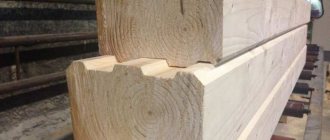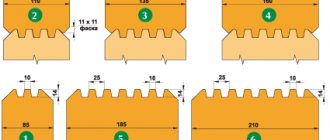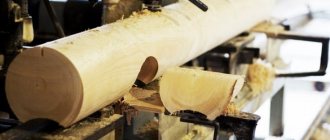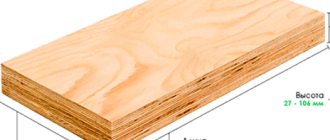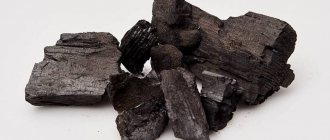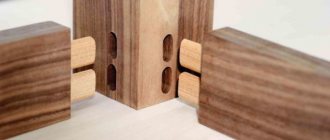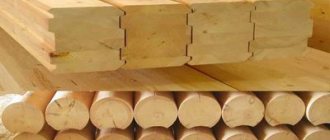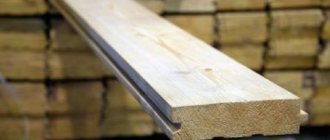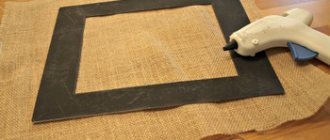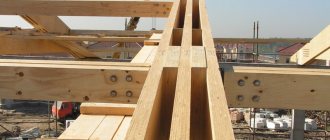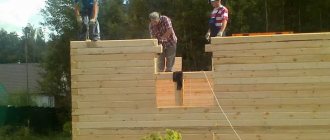You can buy laminated bent timber or send a request by email or phone +78126485435
Today, laminated veneer lumber is a common material for the construction of houses, baths, and decorative structures in summer cottages and garden plots. But what is on sale is mainly the classic form - straight lumber with a profile for connecting the crowns to each other.
But there is also such a type of laminated veneer lumber as bent. Its production is somewhat more complicated, so it will not be possible to purchase 2-3 units from the manufacturing company; ordering (especially according to your own project) starts from 1 cubic meter. Using this material, unique architectural structures are created - gazebos and tent-shaped houses, rounded bay windows and semicircular loggias.
- A little history
- Production of beams and beams of curved shape Vayma
- Steaming
- Factory production of bent timber
A little history
A type of laminated lumber has been common in construction for quite a long time, but curved lumber pressed using glue took on its final form by 1890 - carpenter Otto Hetzer from Germany used casein glue and gave the structures spatiality by bending the elements.
The widespread use of load-bearing laminated wood structures in Europe began in the middle of the 20th century (1960-1970), it was then that the industry began to produce a variety of strong and reliable adhesives for fastening lamellas into a single monolith.
Glued laminated timber was used during reconstruction work at the Trinity Cathedral in St. Petersburg.
Interesting fact: the first composite load-bearing beams made of lamellas were connected using wedges and ties, without any glue. At the same time, their strength allowed them to withstand heavy loads. The idea of connecting beams using a wedge belongs to F. Delorne; he used this technology for the construction of arched parts of palace buildings.
Today, laminated laminated timber with a bend is used in house construction, the construction of water parks and other large tent-type structures.
The use of bent glued beams for the construction of roofs of residential buildings
The most common types of roofs of modern country cottages include:
- Gable. The traditional and simplest form of roofing, which is often found in dachas and compact residential buildings.
- Hip. It consists of two pairs of triangular and trapezoidal slopes. Suitable for large cottages.
Roofs with domed, semicircular or lancet shapes are much less common. The disadvantages of such a roof are the high cost of the bent beams made of laminated veneer lumber used for its manufacture. But it also has many advantages.
Fig.2. How do bent roof beams look in the interior?
Snow mass does not accumulate on the rounded roof and rain moisture does not stagnate. It is more resistant to powerful gusts of wind. It can decorate the interior of an attic if its individual internal elements are made in the form of trusses. In addition, a house with an unusual domed or pointed roof immediately falls into the category of exclusive residential buildings.
Manufacturing of beams and curved beams
In Russia, such production is not widespread, so for a long time, when it was necessary to use bent beams or laminated veneer lumber, craftsmen made do with their own resources. Until now, on construction forums there are at least 3 technologies for self-production of curved laminated veneer lumber of various sections, and each method has modifications thought out by carpentry and carpentry enthusiasts.
Vayms
The simplest carpentry tools that act as clamps will help hold the slats in the desired position until the glue has completely cured. They are made with their own hands from scrap materials. Well suited for making timber or beams with a slight bend without steaming the lamellas. The blanks are cut out immediately with the desired degree of curvature, after which they are assembled with glue and clamped with a clamp.
Steaming
In this case, the lamellas are bent to the desired state after treatment with boiling water or steam. The method is more complicated than the previous one, because you will need basic equipment and a workshop. The essence of the method is to steam wooden blanks - lamellas - and then fix them on a template of the desired shape. After drying and cooling, the wood will retain its shape. Then they start gluing the timber.
The advantages of the method include the ability to bend even hard wood - oak, larch, Karelian birch.
Factory production of bent timber
Convenient and simple solution - just order the required number of products with the selected parameters from specialists. High precision equipment, solving even the most complex problems and using only certified safe adhesive systems are the main advantages of ordering products from the factory.
Cold bending
Cold bending is performed by making cuts on the workpieces at bending points; cuts are made to a depth of 2/3 to 3/4 of the workpiece thickness. The bending radius depends on the thickness of the cuts and the elasticity of the wood. For work, wood of natural moisture is used; beech, oak and birch are more elastic, spruce and pine are less elastic. For this reason, lumber from resinous and soft coniferous species is used less frequently for bending.
Cuts in boards of various sections
Cold bending is used to produce load-bearing bent beams for attics and verandas; with the help of bent structures, openwork canopies and gazebos are erected.
You can make bent beams yourself at home. The cuts in the workpiece are made with a circular saw, the main condition is that the depth of the cuts must be the same. The desired configuration can be set using clamps; the process of drying the wood naturally to a moisture content of 18-22% will take up to 30-40 days. After completion of the process, the workpiece stably retains its shape.
The disadvantage is the partial loss of strength due to the violation of the integrity of the fibers in the cuts; the structures must be made more massive.
The use of curved laminated timber and beams in private buildings
If you look at the projects offered by most construction companies, it becomes clear that bent glued elements are unlikely to be required there. But individual sketches require a non-standard approach.
Curved support beams are used:
- for the construction of load-bearing structures of hip roofs;
- construction of gazebos;
- construction of large tent-shaped structures - water parks, planetariums, entertainment centers.
In private buildings, apart from hip roofs, support beams are rarely used, and curved beams are chosen for the construction of semicircular bay windows, loggias and balconies, architectural elements requiring smooth forms.
Where else are bent laminated beams used?
Bent-laminated wooden elements are also used in the construction of such objects as:
- Buildings for utility purposes: large warehouses, hangars, buildings for keeping animals.
- Industrial buildings: production, assembly, packaging shops, technological lines.
Fig.3. Examples of using bent laminated timber in various buildings - Religious buildings: Orthodox churches, cathedrals, bell towers.
- Facilities for growing plants: greenhouses, greenhouses, winter gardens.
- Covered light buildings: outbuildings, gazebos, verandas, terraces, tents.
Fig.4. Examples of using bent laminated timber in light buildings
Large canopies are also built from this material for shopping and entertainment centers, exhibition and sports halls, and concert venues.
Features of the manufacturing technology of bent laminated beams
Bending laminated veneer lumber is a technologically complex process that should only be carried out in industrial conditions. A professional approach helps prevent the formation of cracks while obtaining the required geometric shape of the beam. It also guarantees the quality and durability of the finished material.
Wood of any type can only be bent using hydrothermal treatment. Under the influence of high temperature and humidity, hard wood becomes plastic. This makes it possible to bend the beam while maintaining its structure. Wood acquires maximum flexibility when the material’s moisture content reaches 30% and the temperature in the central part of the beam reaches 100 degrees. It is difficult to achieve such indicators when producing independently.
Another feature of the production of bent laminated beams is the duration of hydrothermal treatment. The workpiece is fixed to the tire, then steamed for more than an hour until it acquires sufficient plasticity. Sometimes additional grooves are cut in the shape of a rectangle or cone. Such cuts help set the beam to the required radius of curvature. The workpiece is bent using a tire and a press.
Fig.5. How to bend laminated timber
When the product takes on a curved shape, it is dried under special conditions. And only after bringing the humidity level to standard values is it disconnected from the tire. Bent laminated beams are produced by combining curved blanks and gluing them together.
Necessary materials:
- Lumber (boards, beams, slats)
- Wood glue or universal
- Solvent 646 (acetone) - for degreasing.
The manufacturing technology of laminated veneer lumber will be discussed using the example of the production of laminated veneer lumber for the manufacture of window frames at home.
Requirements for source material. The lumber used must be dry and healthy. In this case, I used pine and larch timber (100 by 100 mm), which was stored under a canopy, i.e. natural drying.
We cut the pieces to the required length, with an allowance of 5 cm on each side.
We select three blanks (lamellas) to make one beam. What is important? Since at the first stage only those edges (sides) of the lamellas that are to be glued and in which the groove will be selected are planed and jointed, it is necessary to determine in advance the relative position of the lamellas in such a way that the pattern of the annual rings is multidirectional. To connect the lamellas I used a dowel connection. After sharpening the glued sides, select a groove for the outer lamellas on one side and two grooves for the middle lamella (on both sides). Based on the dimensions of the grooves on the circular saw, we make blanks for the keys.
After manufacturing all the parts of the future block, for preliminary assessment and adjustment, we assemble the timber “dry”, without glue.
Preparing the surfaces to be bonded is an important operation. Depending on the glue used, the order of preparatory steps may vary (see instructions on the glue packaging). But the basic operations, as a rule, are still the same. Usually you need:
- Sand the mating surfaces with sandpaper or, more conveniently, with a grinder.
- Dust the surface with a brush or vacuum cleaner.
- Degrease (I used solvent 646 and a brush), let dry.
- All manufactured parts (joints) should be treated with fire protection, twice with intermediate drying.
After completing these operations, you can begin gluing the timber.
Gluing timber
Gluing timber is the most critical process. It is especially important to choose the right glue here. That is, depending on where (outdoors, indoors) under what conditions (humidity, temperature) the future product will be used, and also depending on the requirements for the appearance of the adhesive joint (color of the glue), it is necessary to select the appropriate adhesive. Now on the market there are practically no problems with the choice of glue.
The gluing technology depends on the chosen adhesive and is usually also indicated on the packaging. As you can see in the photo, the glue is yellow in color (the color issue was not important for me), the glue is intended for use in outdoor work, on wood, the pattern of annual rings on the timber is multidirectional. Defects and chips along the edges of the timber will be removed during finishing of the timber. After gluing, I used clamps to compress and secure the parts to be glued.
Drying of the adhesive joint must be carried out in accordance with the recommendations of the adhesive manufacturer. As a rule, the following conditions must be met:
- Direct exposure of the product to the sun and water should be avoided (for example, I dried it under a canopy)
- The parts to be joined must be pressed firmly along the plane being glued
- Drying times must be maintained in accordance with the manufacturer's recommendations.
I will mention one more non-standard (optional) operation. Taking into account the fact that laminated veneer lumber was created for the production of window blocks, and the force impacts when performing caulk work when installing window blocks are not small. I decided to further strengthen the structure of the beam by installing it on dowels. I used homemade dowels made of oak, with a diameter of 22 mm, using a hole in the lower part of the dowel for a conical wedge (the dowel fits into the spacer on the wedge - when driven in). First I drilled the holes. The dowels and conical wedge were placed on glue. I hammered the dowels in with a sledgehammer.

